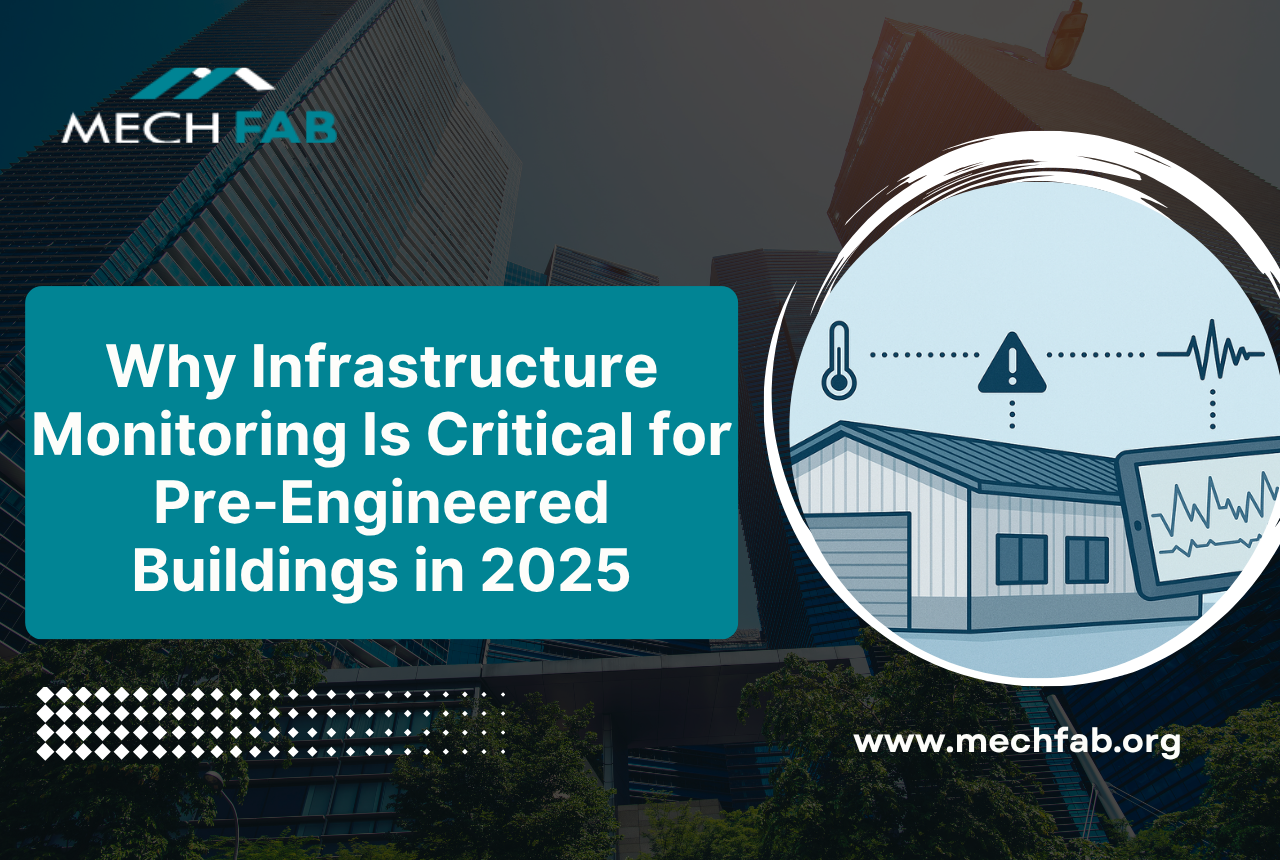When you invest millions in constructing a pre-engineered building, warehouse, or industrial facility, how do you ensure it remains safe, functional, and cost-effective throughout its lifespan? The answer lies in infrastructure monitoring—a sophisticated approach that transforms how we protect and manage our built environment.
Infrastructure monitoring has evolved from simple visual inspections to advanced, technology-driven systems that provide real-time insights into structural health, performance metrics, and potential issues before they become costly problems. For businesses in Guwahati and across Northeast India, understanding these systems can mean the difference between decades of reliable operation and unexpected structural failures.
What Is Infrastructure Monitoring?
Infrastructure monitoring is the continuous process of measuring, analyzing, and tracking the performance and condition of physical structures and their supporting systems. It encompasses everything from the steel framework of your building to the environmental conditions that affect its integrity.
Think of it as a health monitoring system for your building. Just as regular medical check-ups help detect health issues early, infrastructure monitoring identifies structural concerns, performance deviations, and maintenance needs before they escalate into safety hazards or expensive repairs.
Modern infrastructure monitoring follows a three-step cycle: sensors collect data on factors like movement, stress, vibration, and temperature, telemetry systems transfer this information to central platforms, and analytics software converts raw data into actionable insights, alerts, and comprehensive reports.
Why Infrastructure Monitoring Matters for Your Business
The global infrastructure monitoring market demonstrates the critical importance of these systems. The infrastructure monitoring market reached USD 7.95 billion in 2025 and is projected to grow to USD 12.86 billion by 2030, expanding at a 10.10% CAGR. This rapid growth reflects the escalating need for proactive maintenance across aging and new civil assets alike.
For pre-engineered buildings and steel structures, monitoring provides several crucial benefits:
Early Warning Systems: Detect structural issues during the initial stages when repairs are simple and inexpensive. Waiting until problems become visible often means facing exponentially higher repair costs.
Extended Service Life: Regular monitoring helps identify factors that might limit your building’s lifespan, allowing for timely interventions that preserve structural integrity for decades beyond the original design expectations.
Cost Savings: Infrastructure monitoring tools save organizations money in two ways: preventing costly downtime and optimizing resource use by identifying underutilized or overprovisioned systems to reduce waste.
Compliance and Documentation: Many industries require documented proof of structural safety and maintenance. Monitoring systems provide the detailed records needed for regulatory compliance, insurance claims, and safety audits.
Risk Mitigation: For structures near sensitive areas—residential neighborhoods, existing infrastructure, or environmentally protected zones—monitoring ensures your construction activities don’t cause unintended damage to surrounding properties.
How Modern Infrastructure Monitoring Works
Today’s infrastructure monitoring systems leverage cutting-edge technology to provide comprehensive visibility into structural health. Here’s how these sophisticated systems operate:
Sensor Deployment: Projects utilize various sensor types including geotechnical sensors like piezometers and inclinometers, structural sensors such as strain gauges and tiltmeters, environmental sensors, and advanced surveying methods including UAV photogrammetry, laser scanning, and satellite InSAR.
For pre-engineered buildings, sensors might track:
- Stress and strain on steel beams and columns
- Temperature fluctuations affecting expansion and contraction
- Vibration patterns from machinery or environmental factors
- Settlement and ground movement beneath foundation systems
- Moisture levels that could lead to corrosion
Data Collection and Transmission: Modern systems operate continuously or at regular intervals, automatically transmitting data to cloud-based platforms. This eliminates the need for manual inspections while providing far more comprehensive information than visual assessment alone.
Analytics and Visualization: Modern infrastructure monitoring platforms unify logs, metrics, traces, and events from all infrastructure layers, using AI and machine learning models to detect deviations and alert teams before issues impact operations. These systems don’t just collect data—they interpret it, identifying patterns that human observers might miss.
Threshold-Based Alerts: When monitoring detects unusual behaviour, predefined thresholds trigger green, amber, or red level responses, such as slowing construction activities, pausing operations, adding supports, or adjusting project sequencing to prevent risks.
Types of Infrastructure Monitoring Systems
Different structures and applications require tailored monitoring approaches:
Structural Health Monitoring (SHM): Structural health monitoring involves observation and analysis of a system over time using periodically sampled response measurements to monitor changes to the material and geometric properties of engineering structures such as bridges and buildings. For pre-engineered buildings, this focuses on the steel framework’s integrity and performance under various load conditions.
Geotechnical Monitoring: Essential during construction phases, geotechnical monitoring tracks ground movement, settlement, and subsurface conditions that could affect your building’s foundation stability.
Environmental Monitoring: Tracks external conditions like temperature, humidity, wind loads, and seismic activity that influence structural performance.
Performance Monitoring: Wireless platforms, which represent 62% of infrastructure monitoring revenue in 2025, achieve five-year battery life matching wired uptime benchmarks while avoiding conduit and trenching expenses. These systems offer cost-effective, flexible monitoring solutions ideal for both temporary construction monitoring and permanent installations.
Real-World Applications of Infrastructure Monitoring
Infrastructure monitoring isn’t theoretical—it’s actively protecting structures worldwide and preventing failures that could cost lives and billions in damages.
During Construction: Construction phases present the highest risk periods. Real-time monitoring during activities like excavation, steel erection, and load testing ensures safety margins are maintained and adjacent structures aren’t compromised by your project activities.
Post-Construction Operations: Once your facility is operational, ongoing monitoring validates design assumptions, tracks long-term performance, and provides early warning of maintenance needs. This is particularly valuable for industrial facilities where heavy machinery creates continuous stress on structural elements.
Aging Infrastructure: Given the aging condition of much of the nation’s navigation infrastructure, managers need accurate and real-time information on the conditions of structures operating well beyond their expected design lives Army. The same principle applies to commercial and industrial buildings—knowing your structure’s current condition allows informed decisions about renovations, expansions, or replacements.
Technology Trends Shaping Infrastructure Monitoring in 2025
The infrastructure monitoring landscape continues evolving with breakthrough technologies:
Wireless Sensor Networks: Improvements in mesh routing, sub-GHz radios, and energy harvesting enable wireless networks to now achieve five-year battery life, matching wired uptime benchmarks while avoiding expensive conduit and trenching. For large pre-engineered buildings, this means comprehensive monitoring without extensive wiring infrastructure.
AI-Powered Analysis: Companies like Datadog announced new AI-powered observability features in 2025, enabling faster root-cause analysis and predictive performance monitoring across hybrid environments. These intelligent systems learn normal patterns for your specific structure and automatically flag anomalies that warrant attention.
Edge Computing: Edge-optimized AI chips embedded in wireless gateways now execute modal analysis locally, transmitting compressed features rather than raw waveforms—cutting bandwidth costs by 70 percent. This advancement makes sophisticated monitoring more accessible and cost-effective for mid-sized commercial projects.
Digital Twins: Advanced modeling creates virtual replicas of physical structures, allowing operators to simulate scenarios, predict maintenance needs, and optimize performance without physical testing.
IoT Integration: Comprehensive structural health assessment can be performed through the efficient use of real-time test data obtained from various types of IoT sensors, which monitor several health parameters of structures available on cloud-based data storage.
Implementing Infrastructure Monitoring for Your Project
If you’re planning a pre-engineered building or steel fabrication project, consider these steps for effective monitoring implementation:
Assessment Phase: Work with structural engineers to identify critical monitoring points based on your building’s design, intended use, and environmental conditions. For heavy industrial applications, focus on areas subject to the highest stress and vibration.
System Selection: Choose monitoring technology appropriate to your budget, structure complexity, and long-term management goals. Modern infrastructure monitoring answers one fundamental question: “Is my infrastructure working right now?” by collecting, analysing, and visualizing data from servers, containers, VMs, cloud resources, networks, databases, and everything else that comprises your operational environment.
Installation Timing: Baseline monitoring should begin during construction, establishing normal parameters against which future changes are measured. This construction-phase data proves invaluable for long-term performance assessment.
Data Management: Establish clear protocols for who reviews monitoring data, how often, and what actions trigger based on various alert levels. Without proper data management procedures, even the best monitoring system provides limited value.
Maintenance Planning: Use monitoring insights to transition from reactive maintenance (fixing things after they break) to predictive maintenance (addressing issues before failure occurs). This shift dramatically reduces operational costs and prevents unexpected downtime.
Common Challenges and Solutions
While infrastructure monitoring provides tremendous value, implementation isn’t without challenges:
Initial Investment Concerns: The upfront cost of monitoring systems can seem significant. However, infrastructure monitoring tools prevent downtime, which is costly for organizations, and optimize resource use by identifying underutilized or overprovisioned systems. Most systems pay for themselves within a few years through prevented failures and optimized maintenance schedules.
Data Overload: Modern systems generate massive amounts of information. The solution lies in proper threshold configuration and AI-assisted analysis that filters noise and highlights truly significant patterns requiring human attention.
Integration Complexity: For existing facilities adding monitoring systems, integration with current operations requires careful planning. Wireless systems and modular approaches minimize disruption during installation.
Skills Gap: Demand for monitoring services is especially acute in regions where engineer shortages hamper in-house program development. Partnering with experienced monitoring service providers bridges this gap, providing expertise without hiring specialized full-time staff.
The Future of Infrastructure Monitoring
Looking ahead, infrastructure monitoring will become increasingly sophisticated and accessible. Businesses across industries are increasingly adopting hybrid and multi-cloud environments, prompting the need for advanced infrastructure monitoring tools capable of managing performance, reliability, and compliance.
For the construction and steel fabrication industry in Northeast India, this means:
Standardization: As monitoring technology becomes mainstream, expect industry standards and best practices that make implementation more straightforward and cost-effective.
Automation: Increased automation in data collection, analysis, and even remedial actions will reduce the human resource requirements for effective monitoring.
Affordability: Competition and technological advances continue driving down costs, making comprehensive monitoring accessible even for mid-sized commercial projects.
Regulatory Integration: Government agencies increasingly recognize monitoring’s safety benefits, with potential mandates for critical infrastructure and high-occupancy structures.
Making the Smart Choice for Your Infrastructure
Whether you’re constructing a new warehouse in Guwahati, expanding an industrial facility, or managing an existing pre-engineered building portfolio, infrastructure monitoring represents a strategic investment in long-term asset protection and operational excellence.
The question isn’t whether monitoring technology works—decades of successful applications across bridges, dams, tunnels, and buildings worldwide prove its effectiveness. The real question is whether you can afford not to implement monitoring given the potential costs of structural failures, unexpected downtime, and premature asset deterioration.
At MECHFAB, we understand that every rupee invested in your infrastructure must deliver value. That’s why we’re committed to designing and constructing pre-engineered buildings that not only meet immediate needs but remain safe, functional, and cost-effective throughout their entire service life. Infrastructure monitoring plays a crucial role in achieving that goal.






